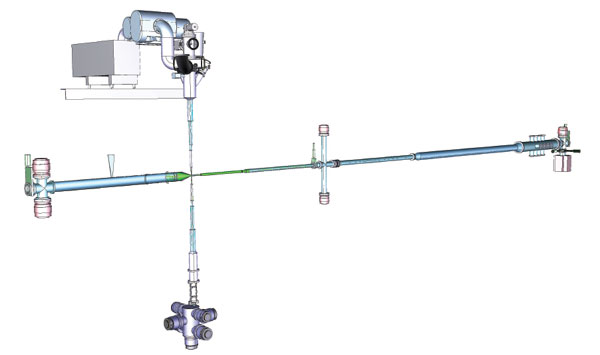PANDA Beamline
Contact: Dieter Prasuhn
The production, accumulation and storage of the antiprotons using protons from SIS 100/200 is described in the technical part of this proposal. The experiments are performed at an internal target station of the High Energy Storage Ring (HESR). Antiprotons traversing the target material without interaction are recirculated in the ring about 500 000 times per second passing also through the electron cooler. At each round trip they can be simultaneously cooled compensating for energy loss and straggling thus maintaining high beam quality. So the beam is used very efficiently and, depending on the interaction rate, can be stored for hours up to many days. The minimum momentum of the antiprotons is 1.5 GeV/c and the maximum is 15 GeV/c. The maximum energy in the cm-system for antiproton-proton collisions is 5.5 GeV, sufficient for associated production of singly charmed baryons (up to Ωc) and corresponding to the upper mass range predicted for charmonium hybrid states. Stochastic cooling of the beam over the whole energy range to a momentum spread of dp/p is an essential requirement. In order to perform high precision charmonium spectroscopy, beam properties below 8 GeV/c momentum must be improved by high energy electron cooling. Momentum spread of the antiproton beam and calibration of the energy should be accurate to a relative precision of ˜10-5.
PANDA Target System
Contact: Alexander Gerasimov (Pellet Target), Alfons Khoukaz (Cluster Target)
Depending on the experimental requirements three target systems are foreseen for the PANDA experiment:
- Cluster beam target
- Pellet beam target
- Fiber target
Cluster target system
Cluster-jet beams for internal storage ring experiments are commonly produced by expansion of pre-cooled gases in micron-sized throat convergent divergent Laval-type nozzles into vacuum. During the passage of the gas through such a nozzle the gas cooles down and forms a supersonic beam. Under appropriate conditions, depending on the type of gas, condensation can take place and nano-particles are created, the so-called clusters. Being dependent of the experimental conditions the size of clusters amounts to typically 103-105 atoms per cluster. Important properties of a cluster beam are a homogeneous volume density distribution, a sharp boundary, and a constant angular divergence determined by the collimators used at the cluster-jet source. Thus a cluster target provides to good approximation a target beam with homogeneous volume density without any time structure in the density and thus without time structure in the luminosity. Furthermore, the absolute target thickness can be adjusted easily during operation.
A prototype of the high-intense cluster-jet source for PANDA is currently in operation at the University Münster and allows for hydrogen target densities in the order of 8x1014 atoms/cm2. Current improvements are expected to lead to even higher numbers. Instead of hydrogen also deuterium can be used as cluster material. Additionally, the use of heavier gases is possible to provide nuclear targets.
Pellet target system
A pellet target provides a regular stream of frozen Hydrogen microspheres (pellets), vertically traversing the accelerator beam. These pellets typically have sizes between 20 μm and 40 μm depending on the size of the injection nozzle. The pellets may be produced more than a meter away from the target. They then traverse the target solenoid and the beam through a narrow tube which puts only minor restrictions on detectors close to the target. The pellet stream has a low angular divergence, thus leading to a position uncertainty of its interaction with the beam of about ±1mm. The pellets fall with a speed of 60 m/s and at a flow rate of 10000 pellets/s, corresponding to a distance of consecutive pellets in the millimeter range. In order to obtain a good time structure, the diameter of the antiproton beam should be in the same order. Since a single pellet undergoes about 100 interactions during the time it traverses the beam, it should be no difficulty to determine the position of individual pellets with the necessary high accuracy not only in transverse but also in the longitudinal direction. A first-generation pellet target was developed in Uppsala with an average thickness of 1016 atoms/cm2 and is in use with the WASA-at-COSY experiment. A more sophisticated target, being the prototype of the later PANDA pellet target, is available at the Forschungszentrum Jülich. It has been developed in collaboration with two groups from Moscow, ITEP and MPEI. With this target also pellets from Nitrogen and Argon have been produced. Other materials, like Deuterium or heavy noble gases, are also feasible.
Nuclear targets
Using a fiber or wire target instead of the cluster or pellet target allows the excellent beam emittance of better than 1 pi mm mrad expected for the HESR to be exploited best. Since fiber or wire targets pose no additional constraints on detectors etc. they will not be discussed further here. Problems with beam heating apply, however, also.





